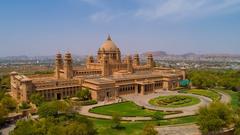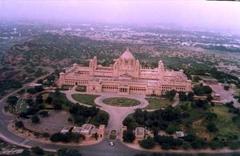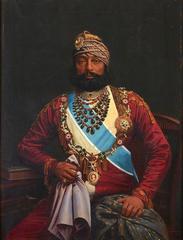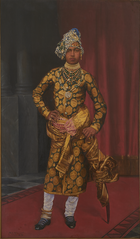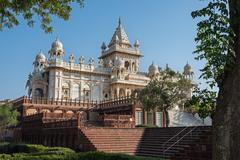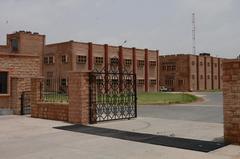
Umaid Bhawan Palace Jodhpur: Comprehensive Visitor Guide
Date: 14/06/2025
Introduction
Perched atop Chittar Hill, the highest point in Jodhpur, Umaid Bhawan Palace stands as an enduring symbol of Rajasthan’s regal heritage, architectural brilliance, and living traditions. Commissioned by Maharaja Umaid Singh during the devastating drought and famine of the 1920s, the palace was envisioned not only as a royal residence but also as a lifeline for thousands of local workers. Today, Umaid Bhawan Palace is renowned as a royal home, a luxury Taj-managed hotel, and a public museum—a destination where the past and present blend seamlessly. This detailed guide covers everything visitors need to know: historical context, architectural highlights, visiting hours, ticketing, cultural experiences, and practical travel advice (Umaid Bhawan Palace Museum, Jodhpur Tourism, Culture and Heritage).
Table of Contents
- Historical Background
- Architecture and Design
- Visitor Information
- Unique Experiences
- Best Time to Visit
- Culinary and Cultural Heritage
- Socio-Economic and Community Impact
- Accessibility and Tips
- Frequently Asked Questions
- Conclusion
- References
Historical Background
Origins and Purpose
Umaid Bhawan Palace’s story is rooted in resilience. In the 1920s, a severe drought struck Jodhpur, and Maharaja Umaid Singh initiated the palace’s construction in 1929 as both a royal project and a large-scale employment initiative. The palace took nearly 15 years to complete, providing crucial livelihoods to approximately 3,000 local craftsmen and laborers at a time of great hardship.
Construction and Legacy
Designed by British architect Henry Vaughan Lanchester, the palace was completed in 1943 at a cost of about $9.45 million. It is one of the world’s largest private residences and continues to function as the principal home of the Jodhpur royal family, now headed by Maharaja Gaj Singh II. In addition, the palace houses a luxury hotel and a museum, ensuring its status as a living monument (Rajasthan Places).
Architecture and Design
Architectural Synthesis
Umaid Bhawan Palace represents a harmonious blend of Beaux-Arts, Indo-Saracenic, Classical Revival, and Art Deco styles. The exterior, constructed with golden-yellow sandstone, is both imposing and elegant, while the interiors feature Makrana marble, Burmese teak, and intricate Art Deco detailing (Culture and Heritage).
Layout and Features
Spanning 26 acres, the palace comprises 347 rooms organized around grand courtyards and corridors. Key features include:
- Throne Chamber: Venue for royal ceremonies, adorned with murals from the Ramayana.
- Banquet and Durbar Halls: Designed for grand gatherings and audiences.
- Library, Ballroom, and Private Dining Rooms: Spaces reflecting an opulent lifestyle.
- Sports and Wellness Facilities: Including an indoor pool, spa, squash and tennis courts.
- Museum: Showcasing royal artifacts, vintage cars, and memorabilia.
Gardens
The palace is surrounded by 15 acres of meticulously landscaped gardens, home to ornamental fountains and peacocks—a serene contrast to Jodhpur’s arid landscape.
Visitor Information
Location and Accessibility
- Address: Chittar Hill, Jodhpur, Rajasthan
- Distance: ~6 km from Jodhpur Railway Station, ~5 km from the airport
- Transport: Easily accessible by taxi, auto-rickshaw, and private vehicle (Tripoto, Travelogy India)
Visiting Hours
- Museum: 10:00 AM – 4:30 PM daily (confirm on official sources for occasional variations)
- Hotel and Restaurants: Operate independently; advance reservations recommended
Tickets and Entry Fees
- Indian Adults: ₹30
- Children (5–11 years): ₹10
- Foreign Nationals: ₹100
- Under 5 years: Free
- Photography: Allowed in most areas with valid ticket; additional fees may apply for cameras (My Visiting Hours)
Guided Tours
Guided tours are available for deeper insights into the palace’s history and architecture. Multilingual guides can be arranged upon request (Travelogy India).
Duration and Facilities
- Suggested Visit: 2–3 hours
- Amenities: Restrooms, parking, cafeteria, souvenir shops
Unique Experiences
- Museum: Explore galleries of royal artifacts, vintage cars, and trophies.
- Gardens: Stroll through lush lawns with peacocks and fountains.
- Cultural Performances: Enjoy live folk music and dance events hosted regularly for guests (Thrillophilia).
- Heritage Hotel Experience: Stay in the Taj-managed hotel for exclusive access and personalized royal hospitality (Taj Hotels).
- Special Events: The palace is a sought-after venue for luxury weddings and high-profile events; check for any event-related closures in advance.
Best Time to Visit
- October to March: Pleasant weather (15°C–28°C), ideal for sightseeing and festivals.
- Summer (April–June): Very hot (above 40°C); plan indoor activities and stay hydrated.
- Monsoon (July–September): Cooler but with occasional rainfall (Travel Setu).
Culinary and Cultural Heritage
- Dining: Experience authentic Rajasthani and North-West Frontier cuisine at Risala, and international options at Pillars, the palace’s signature restaurants (Culture and Heritage).
- Cultural Events: Participate in or witness traditional music, dance, and festival celebrations.
- Museum Programming: The museum supports cultural education and preservation of royal legacies.
Socio-Economic and Community Impact
Umaid Bhawan Palace’s construction provided critical employment during a historical drought. Today, it continues to generate jobs in hospitality, tourism, guiding, restoration, and the arts. The palace’s operations support sustainable tourism and promote local businesses, artisans, and performers (Culture and Heritage).
Accessibility and Tips
- Mobility: The palace and museum offer wheelchair access in public areas, though some heritage sections may have steps or uneven surfaces.
- Dress Code: Modest, comfortable, and climate-appropriate attire is recommended.
- Health: Stay hydrated, especially in summer; avoid peak midday hours in hot months.
- Children & Elderly: The site is family-friendly but involves walking; plan accordingly.
- Photography: Permitted in most areas; restrictions apply in some museum sections.
Frequently Asked Questions (FAQs)
Q: What are the Umaid Bhawan Palace visiting hours?
A: The museum is open from 10:00 AM to 4:30 PM daily (confirm for holidays or special events).
Q: How much are tickets?
A: ₹30 for Indian adults, ₹10 for children (5–11), ₹100 for foreign nationals, free for children under 5.
Q: Can I stay overnight at Umaid Bhawan Palace?
A: Yes, the palace operates a luxury hotel managed by the Taj Group; advance booking is advised.
Q: Is the palace wheelchair accessible?
A: Major public areas are accessible; some heritage sections may have limitations.
Q: Are guided tours available?
A: Yes, in multiple languages; recommended for a richer understanding.
Q: Is photography allowed?
A: Yes, in most public and garden areas; check for restrictions inside the museum.
Conclusion
Umaid Bhawan Palace is more than an architectural marvel—it’s a vibrant symbol of Jodhpur’s royal legacy, community spirit, and cultural vibrancy. It offers visitors a unique opportunity to explore Rajasthan’s history, immerse in royal traditions, and experience world-class hospitality. Plan your visit by noting opening hours, booking tickets or hotel stays in advance, and pairing your trip with nearby attractions like Mehrangarh Fort and Jaswant Thada for a comprehensive Jodhpur experience.
Stay updated by visiting the official palace website and use resources like the Audiala app for personalized travel planning.
References
- Umaid Bhawan Palace Museum
- Jodhpur Tourism
- Culture and Heritage
- Rajasthan Places
- Taj Hotels
- Thrillophilia
- Tripoto
- Travelogy India
- Travel Setu
- Guidetour
- Pluto Tours
